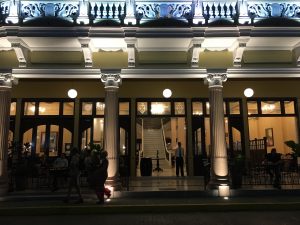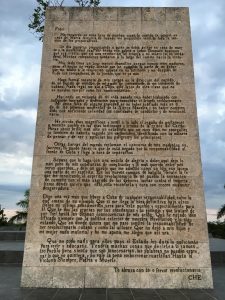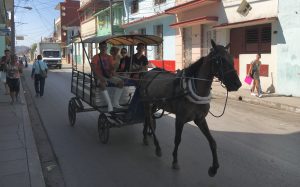
The train arrives in Santa Clara about 6 am and outside the station are a line of horse-drawn taxis.
It’s a 12 or so block walk, past a nice square, ring the bell at our hostal and wait, and wait, and ring and wait.
Back to the well-cared-for central square, sit down at a 24-hour hamburger stand and pay 1CUP each for a coldish glass of an orange-colored beverage. The WiFi is working, our host Alain responds and it’s back again.
The house is in great shape, the toilet and AC works and we sleep until lunch. Alain lives in the house with his mother, is renovating the one next door to expand his operations, and has four or five women employed cleaning and cooking. One makes a stew of beans, malanga(?a type of root vegetable) and smoked pork and sausage. That’s followed by a whole fish for each of us, served on top of fried potatoes along with rice and a salad. Dessert is a soft cheese and mango purée. Well worth the 12CUC.
The heat of the afternoon is avoided by napping and watching Real Madrid lose to Juventus but advance in the UEFA cup tournament on total goals scored.
The hammerıng sun subsıdes, so it’s time for a stroll over to see Che’s tomb where his resignation letter to Fidel is displayed in metal type on the wall.
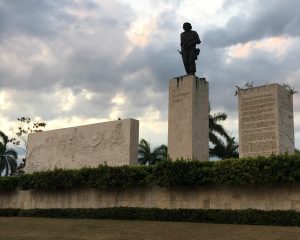
Then, two strange dining experiences. The first, a stop at an ice cream parlor that drew lines earlier in the day. We sit down, learn they don’t have bottled water and bring us the only thing on the menu, small plates of ice cream. It turns out it’s a government run parlor where the public can enjoy heavily subsidized and delicious ice cream.
Next, a pizza place for an appetizer of small wedges of sliced ham called Jamon Viking and a Velveeta-type cheese wilting in the humidity before a pizza made with the same cheese atop a puffy pre-made crust.
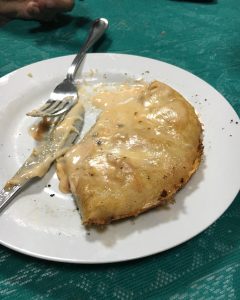
That’s all forgiven by a stop in an exquisite hotel down the block where a tumbler of seven-year old Havana Club rum with one giant ice cube sets me back $1.50CUC.
That soothes the pain of my Yuban delusion but I’m convinced something is still out there. Pondering this, it’s off to one our main objectives, a Cuban baseball game. A 10-minute walk brings us to a sports complex with riverside barbecue grills and tables for picnicking, a few bars and restaurants, a playground and park decorated with an out-of-service fighter jet and helicopter and a large stadium.
Vendors line the parking lot in a row and the ticket lady explains the seats are one or two pesos CUP, and my CUC seem like a headache to her, so I buy a beer outside and get change. She says we can sit in the area behind home plate for foreign visitors and we plop down in the front row behind home plate.
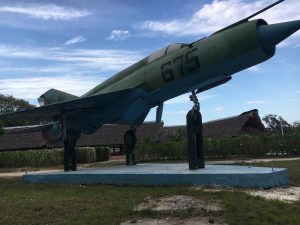
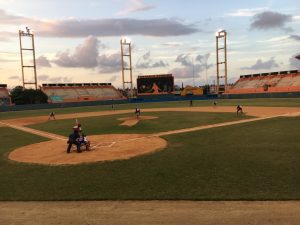
The players are preparing for an upcoming international competition and are split into central and western teams. The Centrales jump on the Occidentales starter early and are up 5-0 after two innings. He seems to have settled down when I come back from the bathroom, which had a 55-gallon drum instead of running water because all of the faucets and the toilet tank were missing or never installed.
The game ends when a light in right field blows out with a tremendous pop and the officials decide to call the game in the sixth inning.
Walking back, I notice
the houses in Santa Clara are generally in much better shape and Alain dismisses Janet’s comments about stairwells and facades, saying people can pool their money for repair. The larger size of many Havana buildings makes me think that’s harder.
The next day, we arrange our scheduled 16-hour train ride to Santiago, where another Airbnb host awaits us. At the snack bar I discover what this country has is a good 4-cent cigar.

Government subsidies provide items that are astonishingly low-priced for foreigners: a four-cent cigar, eight-cent baseball ticket, 24-cent beer. That also helps maintain a low-cost workforce for the tourist hotels, shops and attractions that their employees will never patronize. In some ways, this seems no less bizarre than the out-of-control San Francisco real estate market that spawned Airbnb.
